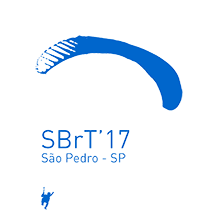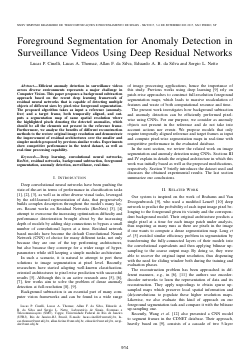
XXXV Simpósio Brasileiro de Telecomunicações e Processamento de Sinais

Novos Códigos Convolucionais Derivados de Códigos Algébrico-Geométricos
Francisco Revson F. Pereira, Giuliano G. La Guardia, Francisco M. de Assis
DOI: 10.14209/sbrt.2017.69
Keywords: Códigos Convolucionais,Códigos Algébrico- Geométricos Construção de Códigos
Abstract
Neste artigo, novas famílias de códigos convolucionais são construídas a partir de códigos algébrico-geométricos (AG). Os códigos convolucionais construídos são novos no sentido que seus parâmetros são diferentes dos parâmetros dos códigos disponíveis na literatura. Em particular, uma família de códigos almost near MDS ou near MDS ou MDS ´e apresentada.Download

Modelagem Estocástica do Algoritmo NSVR-IAF-PNLMS para Dados Gaussianos
Fábio Luis Perez, Eduardo Vinícius Kuhn, Francisco das Chagas de Souza, Rui Seara
DOI: 10.14209/sbrt.2017.70
Keywords: Algoritmo IAF-PNLMS algoritmo NSVR-IAF-PNLMS filtragem adaptativa modelagem estocástica.
Abstract
—Este artigo apresenta um modelo estocástico do algoritmo NSVR-IAF-PNLMS (normalized smoothed variation rate individual-activation-factor proportionate normalized leastmean-square) para sinais de entrada gaussianos reais. Considerando uma matriz de distribuição de ganho variante no tempo, são derivadas aqui expressões de modelo caracterizando o comportamento médio do vetor de coeficientes, da matriz de distribuição de ganhos e da métrica NSVR, bem como a curva de aprendizagem e a matriz de correlação do vetor de erro nos coeficientes. Através de simulações numéricas, a precisão do modelo estocástico é verificada para diferentes cenários de operação.Download

Um Estudo sobre Separação Cega de Fontes e Análise de Componentes Independentes
Marcelo Ramos Romano, Romis Attux
DOI: 10.14209/sbrt.2017.67
Keywords: Blind Source Separation Independent Component Analysis Signal Processing
Abstract
This work is a study of a technique of Blind Source Separation called Independent Component Analysis (ICA). Some of the most important ICA methods will be presented: maximization of kurtosis, negentropy and likelihood and minimization of mutual information. These methods will be implemented and validated for synthetic signals within the software MATLAB. A test with real audio signals will also be carried out.Download

Modelo de Propagação de Ondas Milimétricas em Ambientes Urbanos com Alta Densidade de Espalhadores
Jean C. Silva, Emanoel Costa
DOI: 10.14209/sbrt.2017.68
Keywords: Radio Propagation Model Millimeter Waves Scattering Depolarization Ultra Wide Band.
Abstract
A model of ultra wide band in millimeter wave propagation in urban environments is presented, deterministically considering scattering and depolarization caused by buildings, trees and poles.Download

Seleção de Relays para o Enlace Reverso de Redes Cooperativas Utilizando SC-FDMA com Restrições de Adjacência
Leonardo Paiva, Iran M. B. Júnior, F. Rafael M. Lima, Tarcı́sio F. Maciel, F. Rodrigo P. Cavalcanti
DOI: 10.14209/sbrt.2017.71
Keywords: Cooperative Networks SC-FDMA Radio Re- source Allocation LTE MILP
Abstract
In this article we study relay selection and resource allocation in a cooperative network that employs SC-FDMA (Sin- gle Carrier - Frequency Division Multiple Access) in the uplink direction such as in LTE (Long Term Evolution) system. With SC- FDMA, the frequency resources assigned to a transmitter should be adjacent in the frequency domain (adjacency constraint). We formulate the total data rate maximization problem as a non- linear combinatorial optimization problem. Through algebraic manipulations we managed to convert the original problem in a MILP (Mixed Integer Linear Problem) that can be optimally solved by standard computational solvers. Finally, we present a performance evaluation in order to better understand the impact of the main variables of the presented model on the system performance.Download

Estudo da NMF auxiliada por partitura aplicada a separação de sons de instrumentos musicais
André O. Françani, Magno T. M. Silva
DOI: 10.14209/sbrt.2017.47
Keywords: Blind source separation independent component analysis non-negative matrix factorization music signal processing
Abstract
Recently, score-informed non-negative matrix factorization (SI-NMF) has been used for separation of sounds of musical instruments. Considering this application, we compare in this paper the SI-NMF method with two blind source separation algorithms based on independent component analysis (ICA): infomax (information-maximization) and JADE (joint approximate diagonalization of eigenmatrices).Download

Rede IoT Colaborativa NovaGenesis
Vaner J. Magalhães, Gabriel Scarpioni, Antônio M. Alberti
DOI: 10.14209/sbrt.2017.72
Keywords:
Abstract
Este artigo apresenta uma aplicação do modelo NovaGenesis de Internet do Futuro em uma Rede Colaborativa de dispositivos IoT. Os dispositivos e o núcleo da rede NovaGenesis foram emulados para permitir a coleta de mensagens. Analisando as mensagens obtivemos uma visão de como é construída uma rede de dispositivos IoT onde um nó pode ajudar um outro nó a comunicação com o núcleo da rede, permitido a publicação dos dados sensoriados de forma colaborativa. Mostramos que é possível aplicar as melhorias e novidades de Internet do Futuro em aplicações de IoT reais e complexas.Download

Foreground Segmentation for Anomaly Detection in Surveillance Videos Using Deep Residual Networks
Lucas P. Cinelli, Lucas A. Thomaz, Allan F. da Silva, Eduardo A. B. da Silva, Sergio L. Netto
DOI: 10.14209/sbrt.2017.74
Keywords: Deep learning convolutional neural networks ResNet residual networks background subtraction foreground segmentation anomaly detection surveillance real-time
Abstract
Efficient anomaly detection in surveillance videos across diverse environments represents a major challenge in Computer Vision. This paper proposes a background subtraction approach based on the recent deep learning framework of residual neural networks that is capable of detecting multiple objects of different sizes by pixel-wise foreground segmentation. The proposed algorithm takes as input a reference (anomalyfree) and a target frame, both temporally aligned, and outputs a segmentation map of same spatial resolution where the highlighted pixels denoting the detected anomalies, which should be all the elements not present in the reference frame. Furthermore, we analyze the benefits of different reconstruction methods to the restore original image resolution and demonstrate the improvement of residual architectures over the smaller and simpler models proposed by previous similar works. Experiments show competitive performance in the tested dataset, as well as real-time processing capability.Download

Análise de Ruído Antrópico em Comunicações Através do Solo
Sávio Oliveira de Almeida Neves, André Noll Barreto, Adoniran Judson Braga, Leonardo Aguayo
DOI: 10.14209/sbrt.2017.75
Keywords: TTE Communications Harmonic Filtering and Estimation Critical Communications
Abstract
This article presents how the interference of man-made noises through the present of harmonics, deteriorates the performance of Through-The-Earth Communications. In addition, the authors compare estimation and filtering techniques for harmonic attenuation considering the case that they are at their nominal frequency and a more realistic case where there is deviation from the nominal frequency.Download

Towards an end-to-end speech recognizer for Portuguese using deep neural networks
gor Macedo Quintanilha, Luiz Wagner Pereira Biscainho, Sergio Lima Netto
DOI: 10.14209/sbrt.2017.73
Keywords: deep learning speech recognition recurrent networks connectionist temporal classification
Abstract
This paper presents an open-source character-based end-to-end speech recognition system for Brazilian Portuguese (PT-BR). The first step of the work was the development of a PT-BR dataset—an ensemble of 4 previous datasets (of which 3 publicly available). The model trained on this dataset is a bidirectional long short-term memory network using connectionist temporal classification for end-to-end training. Several tests were conducted to find the best set of hyperparameters. Without a language model, the system achieves a label error rate of 31.53% on the test set, about 17% higher than commercial systems with a language model. This first effort shows that an all-neural highperformance speech recognition system for PT-BR is feasible.Download